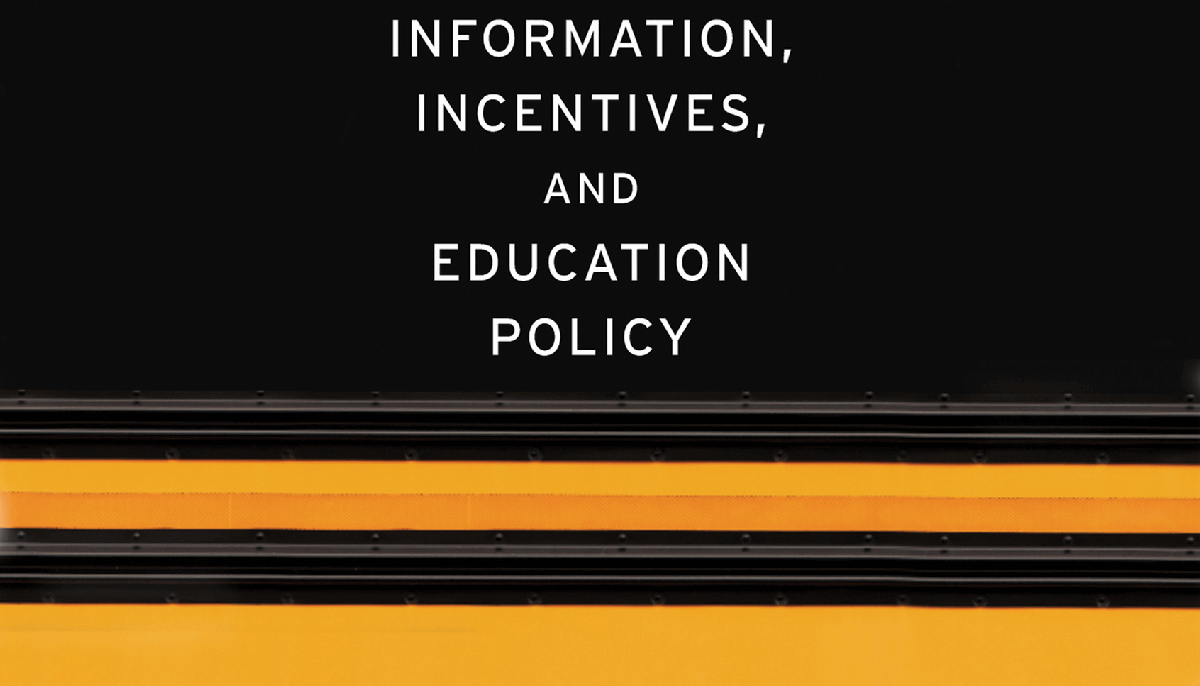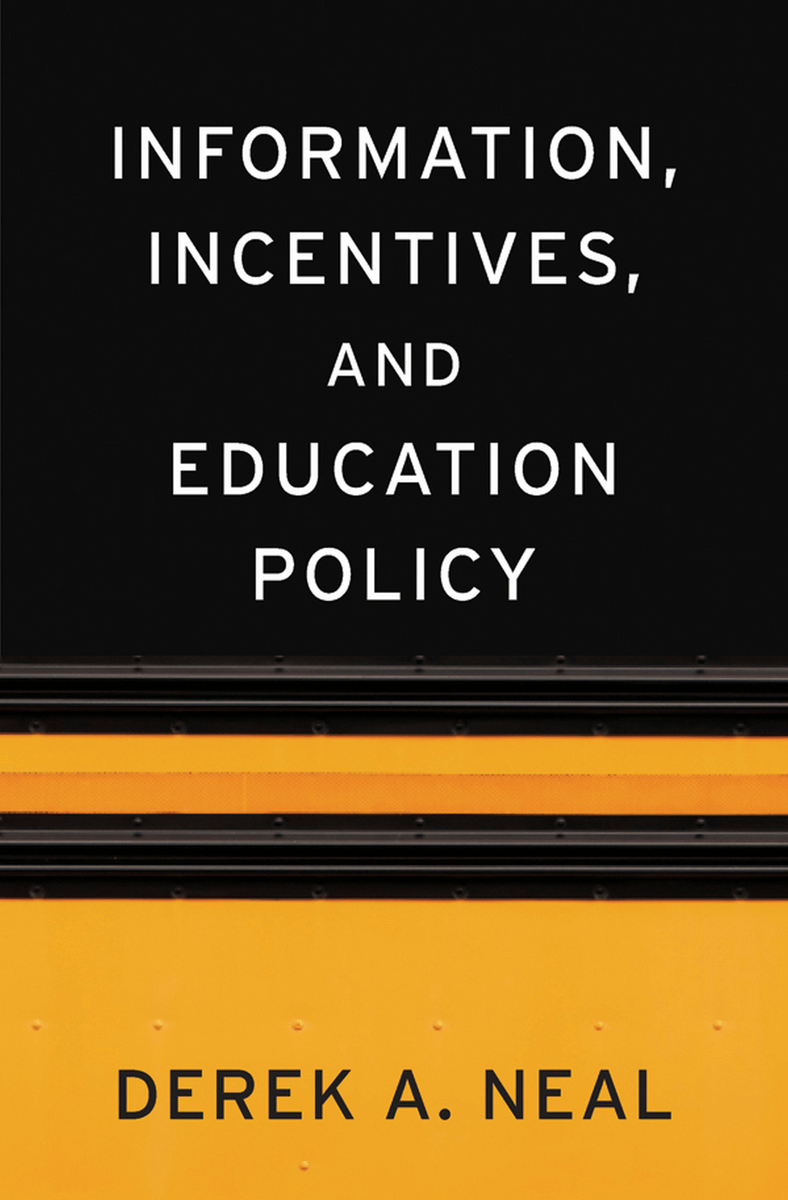
Information, Incentives, and Education Policy
by Derek A. Neal
Harvard University Press, 2018, $39.95; 240 pages.
As reviewed by Michael McPherson
We economists like to say that our main goal in teaching undergraduates is to help them learn “to think like an economist.” I suspect that most of us do a pretty poor job of that, in part because we tend to be slaves to teaching from our textbook of choice, and in part because, like most college professors, we get little or no instruction in how to teach.
Derek Neal seems to be an exception to this rule. Winner of a top teaching award at the University of Chicago, where he is professor of economics, Neal has written a sort of textbook for advanced (actually very advanced) undergraduates on the application of modern economic thinking to some core problems in elementary and secondary education in the United States. Information, Incentives, and Education Policy is a true textbook, complete with problem sets and appendices, but because of the quality of Neal’s reasoning and the range of topics he addresses, it deserves attention beyond that of college students.
Neal has his economist lenses firmly in place as he considers issues in education that range from the fundamental reasons for government investment in schools to the role that parental choice can and should play in determining where kids go to school. He succeeds in showing that the economic perspective offers plenty of instructive insights about American education.
The framework that drives economic analysis in Neal’s work is the concept of “individual maximization under uncertainty.” People who are interested in education, including students, parents, teachers, or even fictitious “people” like school districts, determinedly pursue their individual goals, but these efforts may or may not add up collectively to educational policies and practices that give participants what they most want. The essential contribution economists can make, in Neal’s conception, is to design systems of incentives and institutions that harmonize with individual preferences as efficiently as possible.
In Neal’s hands, the tools of economics are powerful, indeed. Readers will find here as clear and cogent an account as they will find anywhere about why test-based accountability systems such as those that emerged under No Child Left Behind tend to go off the rails in either spectacular ways (the Atlanta cheating scandal) or more mundane ways (teaching to the test). Neal offers an ingenious, though perhaps unrealistic, solution to this problem, which is at base that school systems and states tend to use a single test to serve two distinct purposes: one, to see whether the school system is improving over time (are students learning more?), and two, to compare the performance of different teachers or schools at a given point in time in order to reward or penalize them.
 To achieve the first purpose, tests must have considerable stability in form and content over time, so that the 7th graders of 2010 in a given school district can be compared to those of 2015 in the same district. This stability, however, means that, if the test is used to compare teachers or schools in that district, teachers or principals who have access to the 2010 test can use it to figure out how to “game” the 2015 test. To achieve the other purpose—comparative evaluation of different teachers in a given year—you need to use tests that change sharply in unexpected ways from year to year (for example, by employing multiple-choice questions one year and short essays the next) to make “teaching to the test” impossible. Developing sharply different high-quality tests from year to year is difficult and expensive, and frequent changes in form and content are unsettling to teachers, students, and parents, so this approach is rarely adopted. But note that the reason it is unsettling is precisely that it’s hard to prepare for the test by looking at old tests, taking practice tests, and other strategies. The only option is to try to get students to learn all the material being tested, which is of course the idea.
To achieve the first purpose, tests must have considerable stability in form and content over time, so that the 7th graders of 2010 in a given school district can be compared to those of 2015 in the same district. This stability, however, means that, if the test is used to compare teachers or schools in that district, teachers or principals who have access to the 2010 test can use it to figure out how to “game” the 2015 test. To achieve the other purpose—comparative evaluation of different teachers in a given year—you need to use tests that change sharply in unexpected ways from year to year (for example, by employing multiple-choice questions one year and short essays the next) to make “teaching to the test” impossible. Developing sharply different high-quality tests from year to year is difficult and expensive, and frequent changes in form and content are unsettling to teachers, students, and parents, so this approach is rarely adopted. But note that the reason it is unsettling is precisely that it’s hard to prepare for the test by looking at old tests, taking practice tests, and other strategies. The only option is to try to get students to learn all the material being tested, which is of course the idea.
Traditionally in the United States, children have attended their neighborhood schools, and alert parents have exerted school choice through their selection of where to live, a mechanism Neal does not examine at length. Much of his book is devoted to newer and more explicit mechanisms of school choice, including the newly popular “public school choice” options that allow parents to choose a different school in their district or even in a neighboring one, while sometimes also factoring in schools’ preferences as to the students they want to accept. Neal also examines charter schools, which run on public money but are largely independent of operational control by the local school system; and tuition vouchers, which give money to parents to help them pay for private schools. Neal does a good job of explaining the complexities of these various choice mechanisms and reporting on what is known about their effects. “Choice” is of course the bread and butter of the economic way of thinking, and the analysis in these chapters will serve well in showing readers how, in practice, economists think.
At the same time, this book will also show its readers what economists, at least economists of the market-loving “Chicago school,” don’t think about. Early in the book, Neal asserts that governments should pay for children’s schooling because, while getting an education will boost children’s adult earning power, some parents are too poor or too neglectful to pay for their children’s schooling, and kids can’t get bank loans. Schooling is human capital, human capital is earning capacity, and boosting earning capacity is the core of what schooling is about. Neal does note, briefly, that other benefits have been alleged for schooling, but he omits the rationale the American founders took as central: that an educated citizenry is essential to a democratic society. If you accept that notion, then you have an interest, as someone who cares about democracy, not only in your own children’s education but in other children’s education as well; there is a collective good here that can only be achieved through public action. Also implied is that we have a collective interest in the aims and content of education: we are not just building workers, we are building citizens.
The fact that parents care about schools as more than vehicles to promote future earning power matters notably in regard to tuition vouchers. Neal equates “quality” of schooling with the degree to which it contributes to human capital, but this view overlooks much of what interests parents in private schools. Most private schools have religious affiliations, which parents may seek out either because they want faith-based instruction or in order to have their children educated with others of the same faith. And, less creditably, many white people want their children educated with other white people. Brown v. Board of Education provoked the opening of private “seg academies” throughout the South that excluded black students. When it comes to parents taking an interest in who else is in their children’s classroom, questions about satisfying people’s preferences—as well as what preferences deserve to be respected—come to the fore.
A problem with Neal’s analysis is his assumption throughout the book that parents are for the most part good stewards of their children’s interests. He allows that some parents may not care enough—may not be very “altruistic”—but the tougher questions center not on neglect but on parents’ judgments about what is best for their children. Should parents have the last word? As future adults, children have interests that warrant protection; parents don’t own their kids. Should parents be allowed to send their children to a school that teaches only creationism, or that preaches race hatred? Is it in a student’s long-term interest to be isolated from those of other races? These are big questions germane to school choice on which thinking like an economist may not help much.
Derek Neal has written a valuable book from which readers stand to learn a lot (especially if they don’t grow faint at the sight of an equation). That said, it is unsettling to read an analysis of school choice and school policy in which religion, race, and civic preparation receive only passing attention. It is true that these factors don’t fit well into Neal’s preferred economic models, which assume that what a parent looks for in a school is independent of who her classmates are. Neal explains that peer effects complicate rigorous models of school choice greatly and are beyond the scope of his book, which he intends as an undergraduate text. But, at least in my view, that is not a good enough reason to ignore these central factors almost completely. Thus, useful as this book is, it would be still better if the author had found more opportunities to note important issues closely aligned with the book’s topics, where “non-economic” considerations have significant weight. “Thinking like an economist” is a perfect subset of thinking well.
Michael McPherson is president emeritus at the Spencer Foundation.
This article appeared in the Summer 2019 issue of Education Next. Suggested citation format:
McPherson, M. (2019). An Economist’s Take on Education: A valuable approach, but one with limits. Education Next, 19(3), 79-80.


